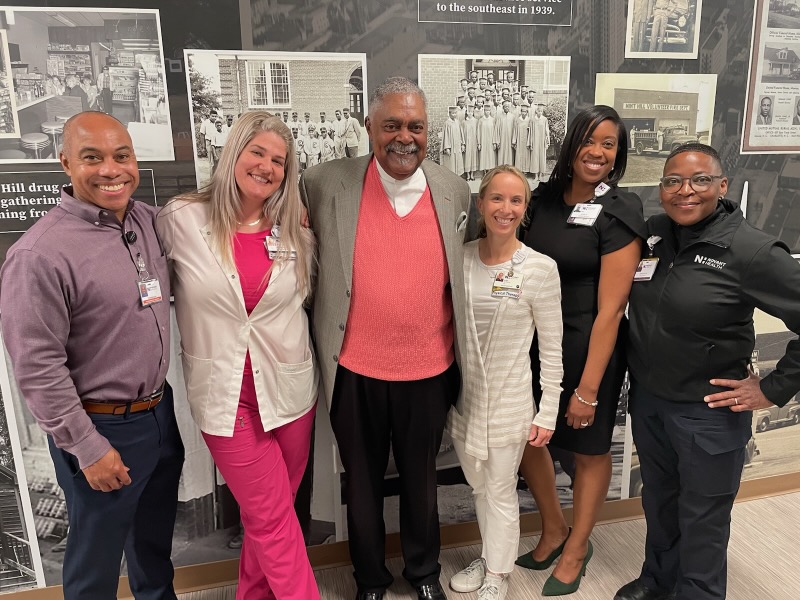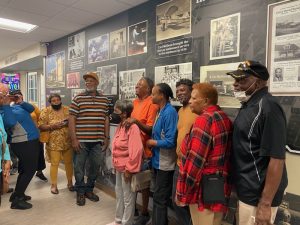
MINT HILL, NC – If you’ve visited Novant Health Mint Hill Medical Center, you’ve likely walked by the Historical Wall located outside of the cafe.
Conceived of by Mint Hill Medical Center President Joy Greear, the wall uses photographs to allow the viewer to step back in time and experience a day in the life of the Mint Hill as it was as far back as 1760. But shortly after the hospital opened, Greear noticed a problem with the wall: it depicted only one facet of Mint Hill’s history and failed to reflect the diverse cultures and experiences present both in Mint Hill’s history and its present-day population.
“The original Mint Hill timeline wall represented a historical step back in time created to allow visitors and team members a way to experience a day in the life of the people and places that influenced Mint Hill,” said Breast Imaging Center Supervisor Jennifer Osley at the wall’s unveiling on May 8. “We soon realized not all of the people and places were represented on our timeline. Joy had a vision for a project to recreate a timeline that captured the cultural richness that exists in Mint Hill.”
Acute Care Rehabilitation Services Manager Lisa Johnson headed a professional support services team tasked with updating the wall. Her team included Osley, Executive Administrative Assistant Avon Graves, Public Safety Services Manager Captain Kendolyn Wright, Environmental Services Director Terrence Martino, and President of the Mint Hill Historical Society Reverend Stan Davis.
“We didn’t want to just find pictures that had African Americans and just put them up there. We wanted to form the relationships, get to know the history of Mint Hill.”
– Lisa Johnson, Acute Care Rehabilitation Services Manager
Together, they embarked on a year-long journey through Mint Hill’s history that involved research, interviews and field trips. “We didn’t want to just find pictures that had African Americans and just put them up there,” said Johnson. “We wanted to form the relationships, get to know the history of Mint Hill.”
At the Charlotte Museum of History, the team learned the history of Rosenwald Schools, which were built during the early 1900s as part of a nationwide initiative set to bring education to the rural underserved communities of the South. They visited the humble grave site near Queen’s Grant Community School where many slaves were laid to rest. They interviewed Reverend Davis and others in the community to get an accurate idea of what a day in the life looked like for Black families in Mint Hill over the past two and a half centuries.
It wasn’t always easy to find the information they sought. The team relied in large part on the Mint Hill Historical Society; like the original wall itself, the Historical Society simply did not have a wealth of information about Black history in Mint Hill. Of course, many Mint Hill residents who could tell the team directly what life was like in the early and even mid-1900s have passed on, and physical records, including genealogy and photographs – especially candid ones – were hard to come by.
“There was not a lot to pull from at the historical society that represented Black history in Mint Hill,” admitted Davis. “At first it looked like it might be the Long family and two or three pictures,” he says, referring to Long Family Mortuary Service led by Lem and Beamon Long and William Aery. Long Family Mortuary Service was established to serve the Black community of Mint Hill in 1947.
But Greear wasn’t satisfied with that, and neither was the team. The product of a year of work, the revitalized Cultural Wall includes 14 additional photos that represent the historical diversity of Mint Hill. The new wall includes Long Family Mortuary Services alongside McEwen Funeral Service and Henderson Grove Rosenwald School next to Historic Bain Academy. It depicts students who attended Clear Creek Union Colored School, the Old Philadelphia Church second site slave cemetery, groups like the Heart to Hand Mason Group and Gunn Home extension and people of the community like Ike Dunn, Curlee Moore, Milas Johnson, and the McGill and Stafford families.
Representation matters. Adding these Black faces, Black stories, to the Cultural Wall has not gone unnoticed by the hospital’s staff nor the community at large.
“It meant a lot to me because I honestly felt embarrassed when I would see Black people in the community come by and have lunch and look at the wall and they didn’t see that representation,” said Graves, “and so to have that up there, it means the world to me because I want to see me in these halls.”
“I felt the same way,” added Captain Wright. “I know that Mint Hill wasn’t an absolutely white community, and we’re a very diverse hospital.”

But it was the reaction of the community gathered to watch the wall’s unveiling that showed its true impact. The hallway outside the cafe was packed on May 8, and as the team began to see nods and hear murmurs of assent as they mentioned people and places that had been added, that’s when they realized: they’re all here. The families and descendents of the new faces added to the wall had all come for the unveiling at Reverend Davis’ invitation.
“When that plastic came down, their faces told the whole story,” Reverend Davis said. “It was so cool to see the people come up her and be like, ‘Oh, that’s my aunt, that’s my grandma!’” added Johnson. “It really made a difference for them.”
Revitalization of Novant Health Mint Hill Medical Center’s Cultural Wall was made possible by funding from the Novant Health Foundation. Visitors are welcome to visit the Cultural Wall located outside the cafe any time before 7:30 pm. Please note that the cafe closes at 6:00 pm daily.
